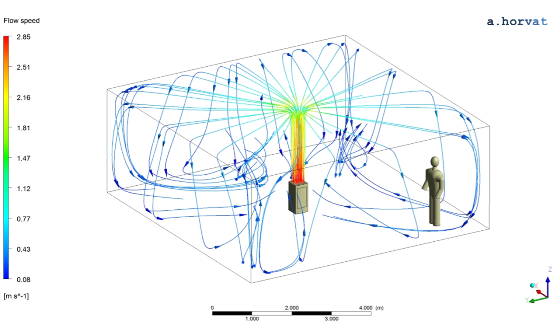The recent COVID-19 pandemic prompted the need for deeper understanding of airflow and
droplet dynamics during a coughing sequence. The transport of droplets influences the spread
of coronavirus and determines implementation of preventive measures such as social distancing and mask wearing.
CFD simulations were performed to determine behaviour of the exhaled air and
infectious aerosols. The data related to cough physiology were found in [1 & 2]. The Cough Peak Flow Rate (CPFR)
was set to 8.5 l/s, which is the upper measured limit.
Airflow and droplet dynamics following a human cough
The analysis results show that trajectories of larger droplets mostly dependent on the initial momentum impulse.
Due to their own weight, their sedimentation is fast and, therefore, their range limited.
Smaller diameter droplets are much more influenced by the exhaled air dynamics.
In general, its temperature is higher than that of the surrounding air, causing an upward motion and further dispersion of smaller droplets. Figure 1 visualises a coughing sequence at 100% ambient humidity when no evaporation occurs. The sedimentation range of most of the droplets is below 2 m, although smaller droplets (marked red) stay suspended even after 3 min.
There is also a strong feedback effect between the droplets and the cloud of exhaled air. Droplet evaporation not only reduces the droplet diameter, but can also provide sufficient cooling to reverse the trend and divert the airflow downward. This may profoundly change the dynamics of the aerosol cloud and significantly increase the droplet sedimentation rate.
In general, its temperature is higher than that of the surrounding air, causing an upward motion and further dispersion of smaller droplets. Figure 1 visualises a coughing sequence at 100% ambient humidity when no evaporation occurs. The sedimentation range of most of the droplets is below 2 m, although smaller droplets (marked red) stay suspended even after 3 min.
There is also a strong feedback effect between the droplets and the cloud of exhaled air. Droplet evaporation not only reduces the droplet diameter, but can also provide sufficient cooling to reverse the trend and divert the airflow downward. This may profoundly change the dynamics of the aerosol cloud and significantly increase the droplet sedimentation rate.

Ventilation conditions induced by an air-purification device
The effects of different ventilation conditions on the airflow and droplet dynamics
in a closed environment were also assessed.
An air purification device was placed in the middle of the room to provide airflow filtration and to stimulate additional sedimentation of smaller diameter (< 30 μm) droplets. Significant improvements in droplet sedimentation were established with the objective to demonstrate the effectiveness of the air-purification device in combating the spread of infections.
An air purification device was placed in the middle of the room to provide airflow filtration and to stimulate additional sedimentation of smaller diameter (< 30 μm) droplets. Significant improvements in droplet sedimentation were established with the objective to demonstrate the effectiveness of the air-purification device in combating the spread of infections.

Initial droplet distribution due to ventilation conditions
References
- J. Gupta, C.-H. Lin & Q. Chen, Flow dynamics and characterization of a cough, Indoor Air, 19, 2009, pp. 517-525.
- X. Xie, Y. Li, H. Sun & L. Liu, Exhaled droplets due to talking and coughing, J. R. Soc. Interface (2009) 6, pp. 703-714.
Dr Andrei Horvat
M.Sc. Mechanical Eng.
Ph.D. Nuclear Eng.
phone
+44 79 72 17 27 00
skype
a.horvat
e-mail
mail@caspus.co.uk
M.Sc. Mechanical Eng.
Ph.D. Nuclear Eng.
phone
+44 79 72 17 27 00
skype
a.horvat
mail@caspus.co.uk

